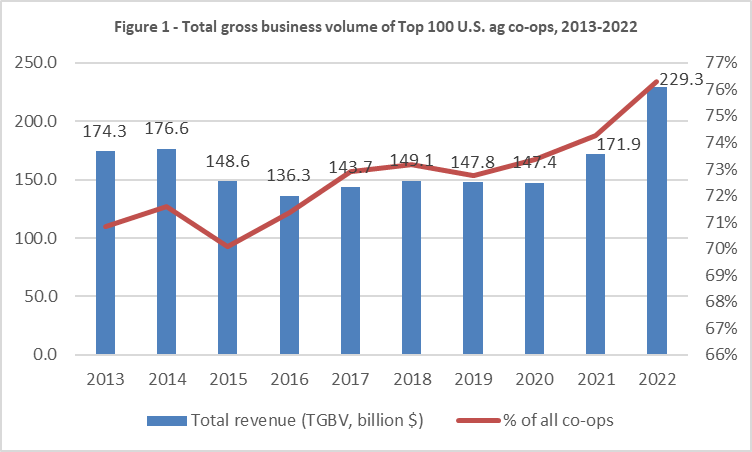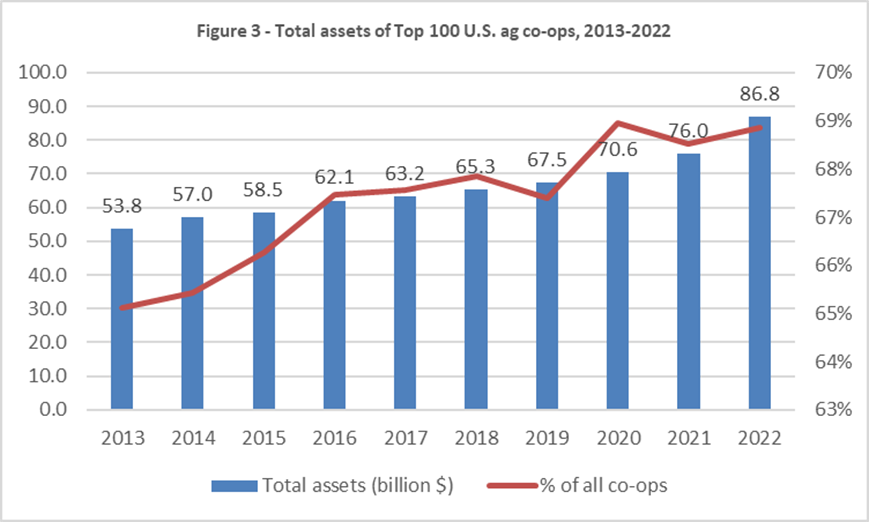   The record net income reflects strong performance of the Top 100 co-ops whereby sales and service revenue increased from 2021 levels. Sales of commodities and supplies increased by 33.9 percent while service and other operating income increased by 24.5 percent in 2022.
In 2022, total gross sales (sales from marketing commodities and selling supplies) was $225.0 billion, up $57 billion from 2021. Revenues from marketing commodities increased by $30.3 billion to $147.4 billion, while supply sales increased by $26.6 billion to $77.6 billion for the Top 100 ag co-ops.
For expenses, other expenses (those not including wages, depreciation, and interest) increased by 46.6 percent, while wages and benefits rose by 18 percent, depreciation by 14.6 percent, and interest by 21.5 percent. These changes resulted in total expenses rising 24.7 percent, finishing the year at $18.1 billion, up from $14.5 billion in 2021. The Top 100 co-ops paid $9.1 billion in wages and benefits to their employees in 2022.
The Top 100 ag co-ops had 76.8 percent of the total gross business revenues of all ag co-ops in 2022, up from 74.9 percent in 2021. Total gross business revenues are comprised of gross sales, service and other operating revenues, patronage from other cooperatives, and non-operating income. Net income after taxes ($9.3 billion) of the Top 100 was 76.3 percent of all ag co-ops.
The $86.8 billion in total assets of the Top 100 ag co-ops in 2022 was an increase of 14.1 percent from 2021. Fixed assets increased by 10.6 percent to $23.6 billion in 2022.
Total liabilities of the Top 100 ag co-ops increased by 16.4 percent to $50.8 billion in 2022 (long-term liabilities increased by $1.2 billion, or up by 8.2 percent). Member equity also increased, totaling $36.0 billion, of which 58.3 percent ($21.0 billion) was equity allocated to members.
Total assets of the Top 100 were 68.9 percent of the total assets of all ag co-ops, while member equity was 65.6 percent of all co-op equity.
Profile of the Top 100
The 100 largest ag co-ops reported serving 665,275 members and employing 109,038 people in full- and part-time positions. Compared to the entire population of the Nation’s ag co-ops, the largest 100 co-ops (6 percent of the total 1,671 ag co-ops) served 36.1 percent of all co-op members and employed 57.7 percent of the people.
Top 100 co-ops operated 4,293 locations (45.2 percent of all co-op locations) in communities across the United States. Thirty-five Top 100 ag co-ops have been operating for more than 100 years, 29 co-ops for 75 to 99 years, 15 co-ops for 50 to 74 years, and 21 for less than 50 years. The average size of the board of directors of Top 100 ag co-ops is 13, while the average size of boards of all ag co-ops is 8.
Most of the Top 100 ag co-ops (46 of them) have diverse operations, noted as mixed type ag co-ops with varying combinations of commodities marketed and supplies sold. There were 17 co-ops in the Top 100 that marketed milk and milk products (dairy), 13 marketed grains and oilseeds, 6 marketed fruits and/or vegetables, and 4 marketed sugar. Six more were supply co-ops, 3 were livestock, and 5 co-ops were in the other category (commodities including rice, cotton, and nuts).
Iowa, Minnesota, and California had highest Top 100 ag co-op sales
Sixty-seven of the 100 largest ag co-ops operate in more than one State, 49 of those operate in more than 2 States, and 39 operate in more than 3 States. The other 33 co-ops operate within one State.
- Iowa had 36 Top 100 ag co-ops operating within its borders which conducted $25.1 billion in net sales, a combination of $16.8 billion in commodities marketed and $8.3 billion in supply sales.
- Minnesota had $16.6 billion in net sales conducted by 32 Top 100 ag co-ops, and 13 co-ops had $14.4 billion in net sales in California.
- Nebraska ($11.1 billion) and Illinois ($10.5 billion) also topped $10 billion in sales, by 20 and 24 co-ops, respectively.
Net sales of the 100 largest ag co-ops totaled a record $191.7 billion, $141.1 billion from marketing commodities and $50.6 billion from selling supplies. These co-ops also conducted $33.3 billion in business between themselves, and when added to net sales, resulted in the total $225.0 billion in gross sales of the Top 100 co-ops.
CHS, Inc. again tops the USDA Top 100 ag co-op list
CHS Inc., Inver Grove Heights, Minnesota—an energy, farm supply, grain and food co-op—is the nation’s largest agricultural co-op (in fact, it is the largest U.S. co-op of any kind) and has held that position for many years. In 2022, CHS had total gross business revenue of $48.6 billion and total assets of $18.8 billion. Dairy Farmers of America, a dairy co-op headquartered in Kansas City, Kansas, is in the 2nd position in the listing with total revenue of $24.6 billion and assets of $7.7 billion. Land O’Lakes of Saint Paul, Minnesota, a diverse supply, dairy, and food co-op is ranked third with $19.3 billion in total gross revenues and $9.8 billion in assets.
Tracking the Top 100
Tracking the Top 100 co-ops’ performance year-to-year provides insight into trends and economic forces impacting ag co-ops and their member owners. The various financial ratios discussed may also serve as a yardstick that all co-ops can compare their own status to. In 2022, the Top 100 co-ops employed record assets and had record business volume, sales, and net income. These top co-ops showed significant financial and operational strength.
Strong financial performance allows co-ops to invest in additional or renewed operational assets; use funds to shore up their financial foundation and to pay out patronage refunds and revolve member equity to members. The operations of the nation’s 100 largest agricultural cooperatives represent a wide diversity of agricultural businesses. As such, it is difficult to point to two or three reasons for the ranking changes that occurred on the list in the past year. While there are several reasons that a co-op’s rank, total business volume, revenue, expenses, and income may change on a year-to-year basis; these factors vary depending upon the sector the cooperative operates within. Total business revenue changes can be influenced by:
- Cooperative-sector structural changes, such as mergers and dissolutions and/or co-op participation in LLCs, joint ventures, and partnerships,
- Prices and supply and demand conditions (outside reports showed that certain commodity and supply input prices rose significantly, and demand for various commodities increased in 2022, helping to explain some of the increase in sales and other revenues),
- Energy-sector performance, food-price fluctuations, trade circumstances,
- Crop, land, and weather conditions; etc.
It remains important to keep these and other factors in mind when assessing the rank and performance of the Top 100 U.S. agricultural co-ops.
While this analysis focused on the Top 100 ag co-ops, it does not diminish the importance of small- to mid-sized ag co-ops and their significant contributions to agriculture and the food and fiber system. All co-ops operate to effectively serve members, striving to provide them with excellent services and greater economic benefits than they would otherwise experience without their direct participation in the cooperatives. Indeed, ag co-ops of all sizes and types play a critical role in the food and fiber economy of the United States and together, they all positively impact rural and urban communities, and farmers and consumers throughout the Nation.
|